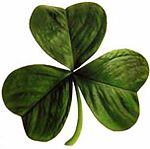|
Practically Lives Here
How Do You Identify?:
.
Preferred Pronoun?:
.
Relationship Status:
.
Join Date: Jun 2011
Location: .
Posts: 11,495
Thanks: 34,694
Thanked 26,362 Times in 5,875 Posts
Rep Power: 21474862
|

My grandmother, Mary Farrell, born in Glengarriff Ireland, often spoke of the history associated with St.Patrick's Day, and so, like femmeInterrupted, I think about her a lot at this time of year...
Lá Fhéile Pádraig Sona Daoibh!
~~~~~~~~~~~~~~~~~~~~~~~~~~~~~~~~~~~~~~~~~~~~~~
St. Patrick was born in Roman Britain at Banna Venta Berniae, a location otherwise unknown, though identified in one tradition as Glannoventa, modern Ravenglass in Cumbria. Calpornius, his father, was a deacon, his grandfather Potitus, a priest. When he was about sixteen, he was captured and carried off as a slave to Ireland. Patrick worked as a herdsman, remaining a captive for six years. He writes that his faith grew in captivity, and that he prayed daily. After six years he heard a voice telling him that he would soon go home, and then that his ship was ready. Fleeing his master, he travelled to a port, two hundred miles away,where he found a ship and, after various adventures, returned home to his family, now in his early twenties.
Patrick recounts that he had a vision a few years after returning home:
I saw a man coming, as it were from Ireland. His name was Victoricus, and he carried many letters, and he gave me one of them. I read the heading: "The Voice of the Irish". As I began the letter, I imagined in that moment that I heard the voice of those very people who were near the wood of Foclut, which is beside the western sea—and they cried out, as with one voice: "We appeal to you, holy servant boy, to come and walk among us."

The reputed burial place of St. Patrick in Downpatrick (Dún Pádraig), Northern Ireland

According to legend, St. Patrick used the 3-leaved shamrock to explain the Holy Trinity to the Irish people.
Wearing of the green
Originally, the colour associated with Saint Patrick was blue. Over the years the colour green and its association with Saint Patrick's Day grew. Green ribbons and shamrocks were worn in celebration of St Patrick's Day as early as the 17th century. Saint Patrick is said to have used the shamrock, a three-leaved plant, to explain the Holy Trinity to the pagan Irish, and the ubiquitous wearing and display of shamrocks and shamrock-inspired designs has become a feature of the day. In the 1798 rebellion, to make a political statement, Irish soldiers wore full green uniforms on 17 March in hopes of catching public attention. The phrase "the wearing of the green", meaning to wear a shamrock on one's clothing, derives from a song of the same name.
|